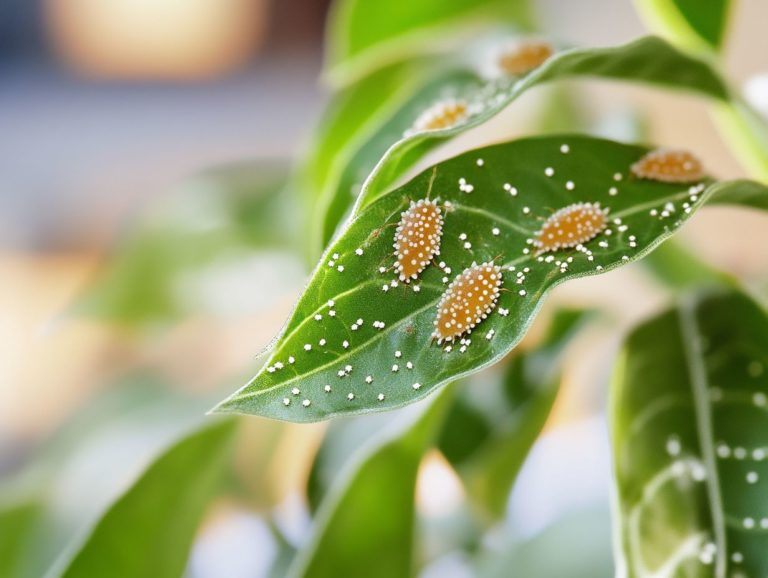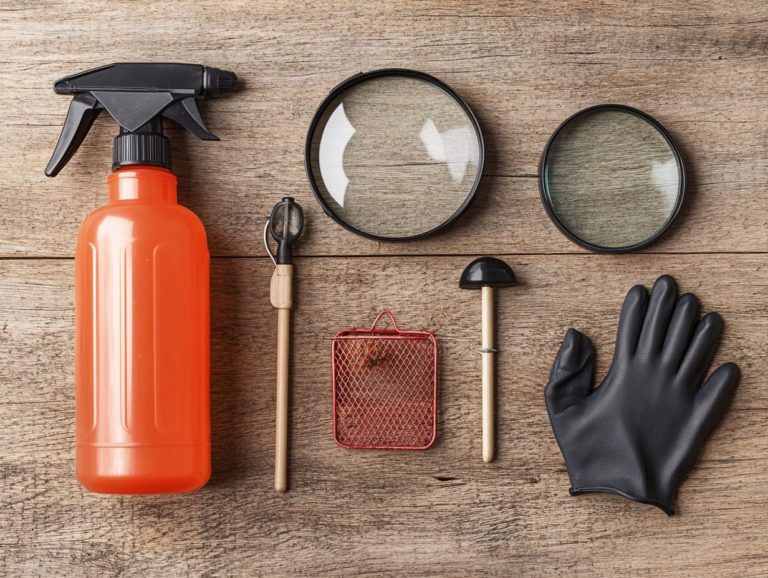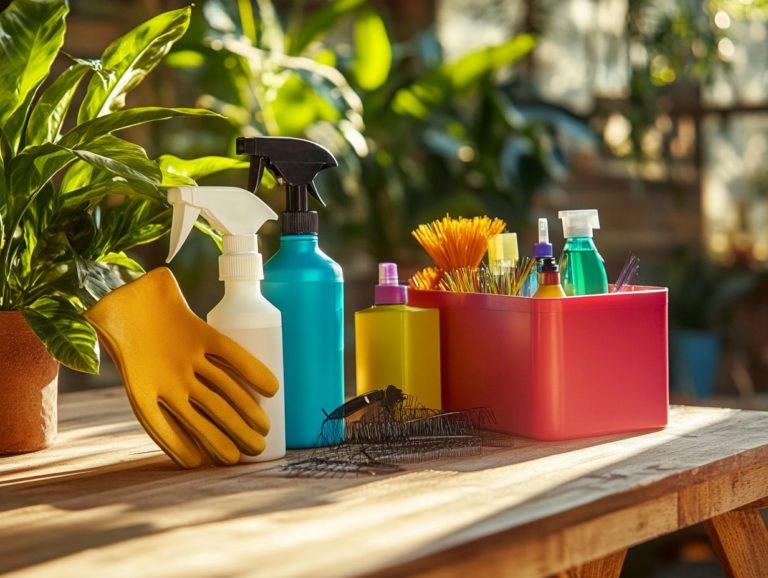Managing Whiteflies on Houseplants
Whiteflies can truly be a gardener’s worst nightmare, particularly when it comes to your beloved houseplants. These tiny pests can ruin the beauty of your plants. If you don’t act, they can also cause major damage.
In this article, you’ll learn to identify these pests. You’ll see how they look, their behavior, and the signs of an infestation. You’ll also discover effective prevention and treatment methods, ensuring your houseplants remain healthy and vibrant. Get ready to take back control of your indoor garden!
Contents
- Key Takeaways:
- Understanding Whiteflies
- Signs of Whitefly Infestation
- Preventing Whiteflies on Houseplants
- Treating Whitefly Infestations
- Managing Whitefly Populations
- Long-Term Prevention and Control Strategies
- Frequently Asked Questions
- What are whiteflies?
- How do whiteflies affect houseplants?
- How can I identify whiteflies on my houseplants?
- What are some natural ways to manage whiteflies on houseplants?
- Are there any chemical pesticides that can effectively manage whiteflies on houseplants?
- How can I prevent whiteflies from infesting my houseplants?
Key Takeaways:
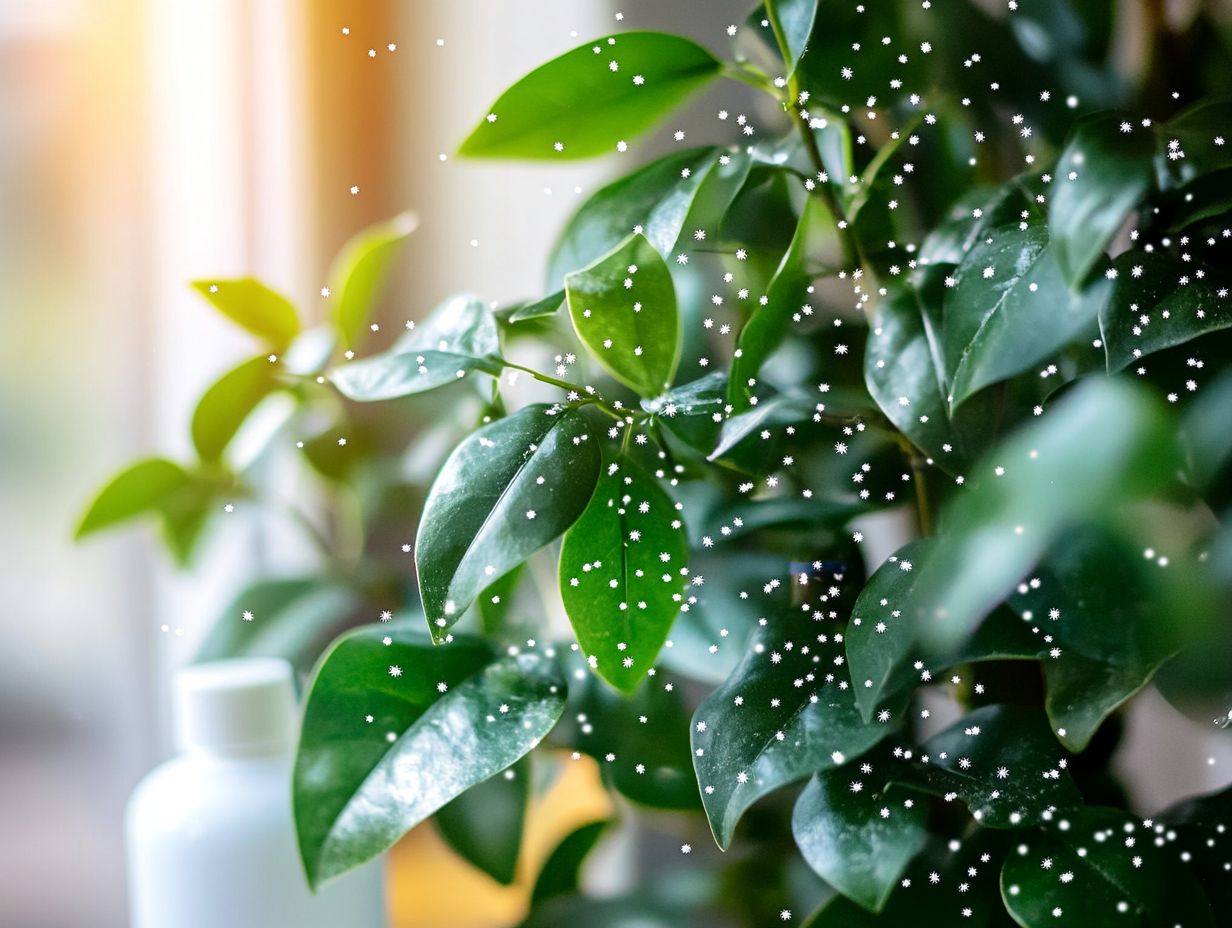
- Regularly inspect your houseplants for signs of whitefly infestation, such as yellowing leaves and sticky residue, to catch and treat the problem early.
- Proper plant care and maintenance, such as keeping plants well-watered and removing dead leaves, can help prevent whiteflies from infesting your houseplants.
- For effective whitefly control, consider using natural methods like introducing beneficial insects such as ladybugs or lacewings or using homemade remedies. Be prepared to use chemical treatments if the infestation is severe.
Understanding Whiteflies
Understanding whiteflies is essential for effective pest management in your garden, particularly if you re nurturing sensitive plants like tomatoes, bell peppers, and eggplants. These small, winged insects can cause problems throughout their life cycle, which includes distinct stages such as eggs, nymphs, larvae, and adults.
Infestations can significantly diminish plant vitality. Therefore, it’s crucial for you to identify the species at play and take the right steps. Recognizing natural predators will help you manage whiteflies better.
Appearance and Behavior
Whiteflies possess distinct physical traits that make identifying them easy. As adults, they appear as small, moth-like creatures. Their nymphs are flatter and often more elusive, lurking on the undersides of leaves.
Adult whiteflies are typically about one-sixth of an inch long, showcasing white, powdery wings that fold elegantly over their bodies. This gives them the appearance of tiny moths flitting about your plants. On the flip side, nymphs are usually translucent or pale yellow and tend to cluster densely, making them tricky to spot.
These pests feed on plant sap, stressing the plants and creating honeydew, a sugary byproduct that can lead to unsightly sooty mold. To catch a glimpse of these intruders, check the undersides of leaves on warm days, especially during late spring or summer. Keep an eye out for sticky residue or black mold, as these are signs of an infestation waiting to be addressed.
Signs of Whitefly Infestation
Spotting whitefly signs is key to protecting your plants. Look for common indicators such as yellowing leaves, wilting, and the appearance of a sticky substance known as honeydew.
This honeydew can foster the growth of black sooty mold on affected plants, further compromising their health.
Identifying Damage and Symptoms

It’s important to recognize damage caused by whiteflies for effective management. You ll often notice symptoms like yellowing leaves, stunted growth, and reduced fruit yield in affected plants like okra and cabbage.
These pests drain the vitality from various crops, such as okra and cabbage. They also produce a sticky residue called honeydew, which can attract sooty mold. This mold can further hinder photosynthesis, worsening the decline in plant health.
As whiteflies multiply, consequences become clear through wilting and distorted leaf growth. This ultimately diminishes the plants’ overall vigor. These visible signs act as crucial indicators of an underlying pest issue, highlighting the importance of timely intervention to protect productivity and ensure a thriving harvest.
Preventing Whiteflies on Houseplants
Preventing whiteflies on your houseplants demands a proactive strategy that emphasizes the health of your plants and vigilant monitoring of environmental conditions, especially in a greenhouse setting.
By utilizing nitrogen-rich soil, you can foster robust growth. This enhances your plants’ resilience against whitefly infestations and other pests.
Proper Plant Care and Maintenance
Proper plant care and maintenance can dramatically decrease the risk of whitefly infestations. Ensure your plants thrive in nitrogen-rich soil and receive the right amounts of water and sunlight.
Maintaining optimal soil quality is essential. Well-aerated, nutrient-dense substrates foster strong root systems that are more resilient against pests. A consistent watering schedule prevents plant stress, which might invite unwanted guests like whiteflies.
In terms of light exposure, position your plants in spots where they bask in bright, indirect sunlight. This promotes healthy growth while minimizing the risk of leaf scorch.
By prioritizing these techniques, you can cultivate strong plants that resist infestations. This enhances your garden’s resilience against pests.
Natural and Chemical Prevention Methods
Mixing natural and chemical methods is a great way to fight whiteflies! Neem oil and insecticidal soap are standout options, proudly approved by the Environmental Protection Agency for safe use on your plants.
You can introduce beneficial insects like ladybugs or lacewings to create a natural balance in dealing with those pesky pests. You might also want to consider diatomaceous earth; it s a fantastic way to deter whiteflies without causing harm to the environment.
If you find yourself in a bind, use systemic insecticides, which are chemicals absorbed by plants to kill pests, as a last resort. Always stick to the label instructions to minimize any negative impact. Proper application techniques and timing can boost effectiveness while keeping non-target species safe.
By following safety guidelines and opting for environmentally friendly alternatives, you enhance your pest control efforts and contribute to sustainable gardening practices that help protect our precious ecosystems.
Treating Whitefly Infestations
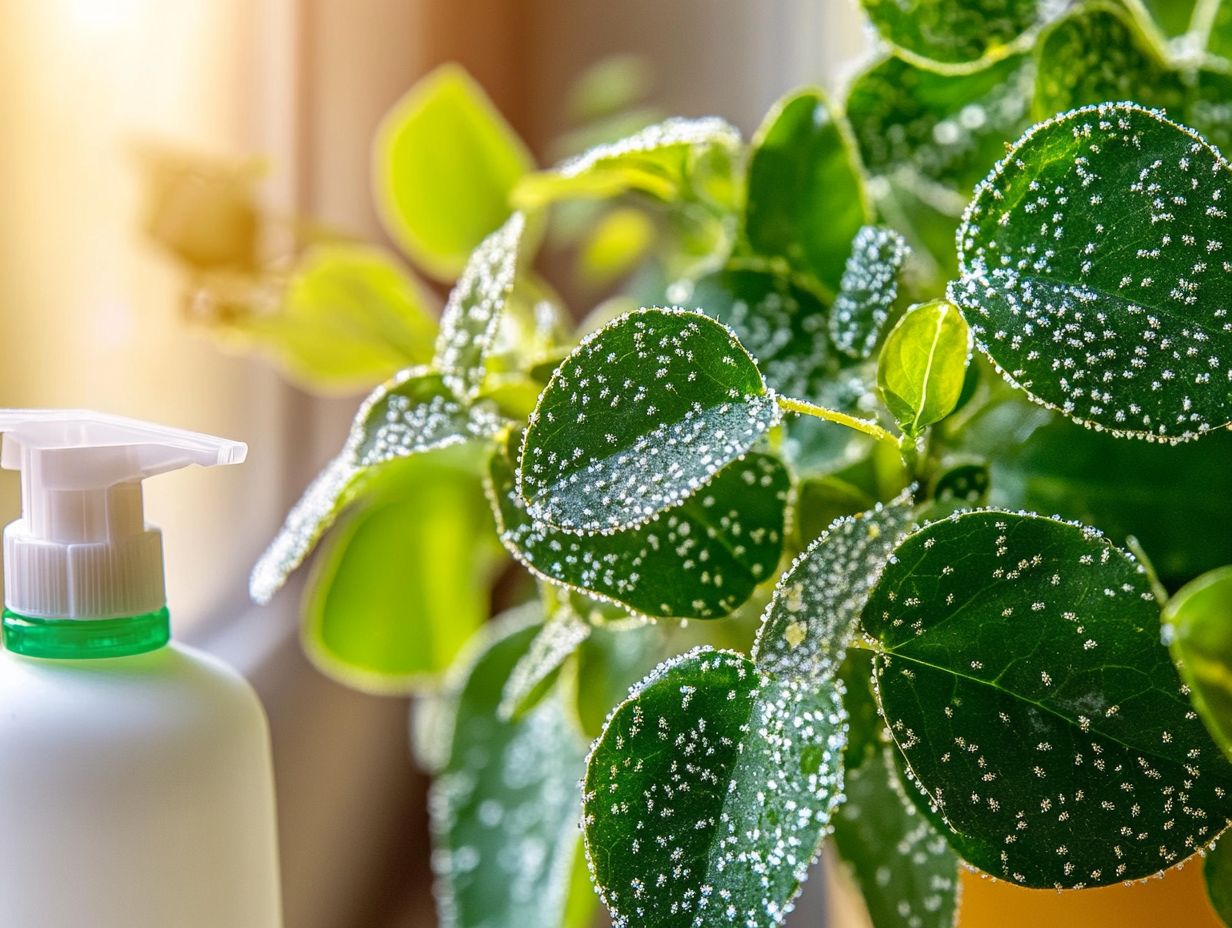
Addressing whitefly infestations requires a thoughtful blend of organic and chemical solutions. Try neem oil and pyrethrin; they work wonders against these pests, ensuring your plants remain healthy and thriving.
Organic and Chemical Treatment Options
When tackling whitefly infestations, you have options between organic and chemical treatments, including neem oil, insecticidal soap, and pyrethrin.
These methods yield varying degrees of success. Neem oil serves as a natural repellent, while insecticidal soap works by suffocating pests on contact. Organic treatments are less harmful to beneficial insects and the environment, making them a favored option for sustainable gardening. However, they often require more frequent applications compared to their chemical counterparts.
On the other hand, chemical treatments can swiftly eliminate a large number of whiteflies, but they pose risks to non-target species and the potential for resistance to develop over time. Assess your specific situation, such as the size of the infestation and the possible environmental impact, before settling on the best course of action.
Don’t overlook post-treatment care. Monitoring for new infestations and maintaining healthy plant conditions are critical for preventing mealybugs in houseplants in the long run.
Managing Whitefly Populations
Effectively managing whitefly populations requires a carefully considered strategy that harmonizes immediate treatments with long-term control methods. By incorporating natural predators like ladybugs and lacewings into your approach, you can significantly diminish whitefly numbers over time, fostering a healthier ecosystem.
Long-Term Prevention and Control Strategies
Implementing long-term prevention and control strategies for whiteflies is crucial, especially in greenhouse environments. These pests can multiply swiftly, so proactive measures are essential.
One highly effective approach is crop rotation. This method disrupts the life cycle of whiteflies and gradually reduces their population. By alternating different plant families, you can create an environment that deters these pests from establishing a stronghold. For additional strategies, check out these tips for dealing with indoor plant flies.
Consider companion planting as well. Certain species naturally repel whiteflies, while others attract beneficial insects that prey on them. Cultivating a healthy ecosystem within your greenhouse encourages a greater variety of plants, significantly decreasing the chances of pest outbreaks.
Regular monitoring of whitefly populations allows for timely adjustments to your strategies. This ensures that your interventions remain effective and sustainable over time.
Frequently Asked Questions
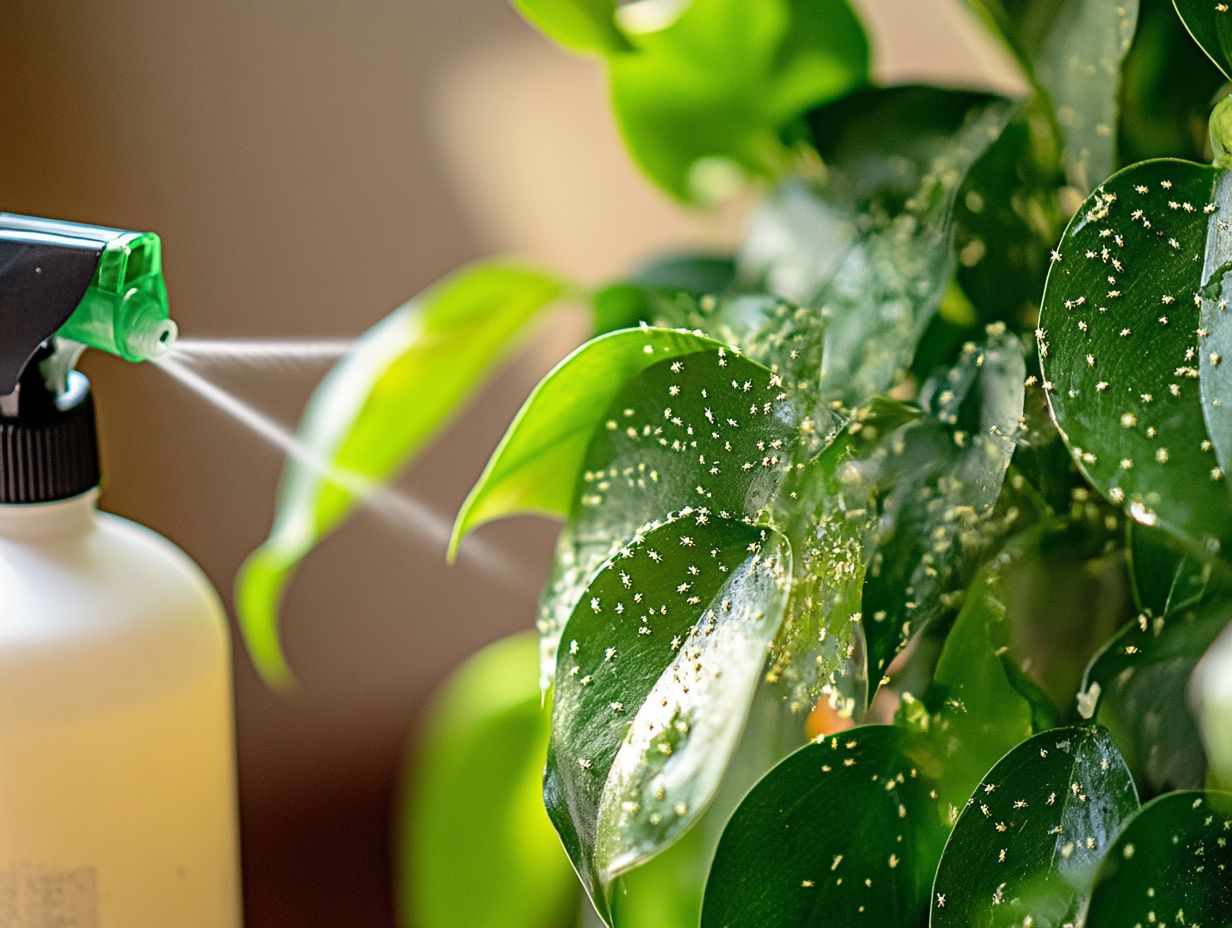
What are whiteflies?
Whiteflies are small, winged insects commonly found on indoor and outdoor plants. They are typically about 1/16 of an inch long and white or pale yellow in color.
How do whiteflies affect houseplants?
Whiteflies feed on the sap of plants, causing wilting, yellowing, and stunted growth. They leave behind a sticky residue called honeydew, which attracts other pests and promotes the growth of fungi.
How can I identify whiteflies on my houseplants?
Whiteflies are usually found on the undersides of leaves. To identify them, shake the plant or use a white piece of paper to gently brush the leaves. If whiteflies are present, they will fly off and leave tiny white spots on the paper.
What are some natural ways to manage whiteflies on houseplants?
One natural method involves using a spray bottle filled with water and a few drops of dish soap. This creates a soapy water solution that can be sprayed onto affected plants to suffocate and kill the whiteflies. You can also introduce natural predators, like ladybugs, to help control the whitefly population.
Are there any chemical pesticides that can effectively manage whiteflies on houseplants?
Yes, chemical pesticides are available, but it s important to read and follow the instructions carefully. Options include neem oil, insecticidal soap, and pyrethrin-based products. Try to control whiteflies using natural methods first before resorting to chemical pesticides.
How can I prevent whiteflies from infesting my houseplants?
Keep your plants safe from whiteflies by regularly checking for any signs of trouble. Healthy plants are less likely to attract pests, so ensure they are well-maintained. Avoid over-watering and over-fertilizing, as whiteflies are drawn to plants with high nitrogen levels.



